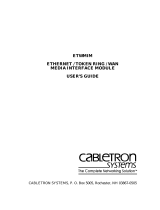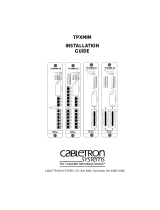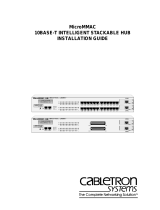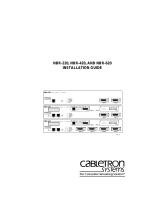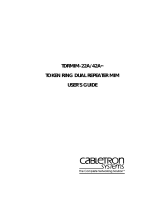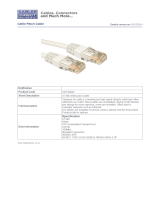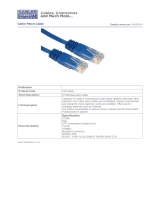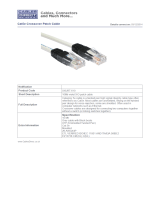Page is loading ...

Cabletron Systems
Cabling Guide


i
Notice
Notice
Cabletron Systems reserves the right to make changes in specifications and other information
contained in this document without prior notice. The reader should in all cases consult Cabletron
Systems to determine whether any such changes have been made.
The hardware, firmware, or software described in this manual is subject to change without notice.
IN NO EVENT SHALL CABLETRON SYSTEMS BE LIABLE FOR ANY INCIDENTAL, INDIRECT,
SPECIAL, OR CONSEQUENTIAL DAMAGES WHATSOEVER (INCLUDING BUT NOT LIMITED
TO LOST PROFITS) ARISING OUT OF OR RELATED TO THIS MANUAL OR THE INFORMATION
CONTAINED IN IT, EVEN IF CABLETRON SYSTEMS HAS BEEN ADVISED OF, KNOWN, OR
SHOULD HAVE KNOWN, THE POSSIBILITY OF SUCH DAMAGES.
Copyright
1996 by Cabletron Systems, Inc. All rights reserved.
Printed in the United States of America.
Order Number: 9031845-02E1 December 1996
Cabletron Systems, Inc.
P.O. Box 5005
Rochester, NH 03866-5005
Cabletron Systems
,
SPECTRUM
,
BRIM
,
DNI
,
FNB
,
LANVIEW
,
Multi Media Access Center
, are
registered trademarks, and
Bridge/Router Interface Modules
,
BRIM-A100
,
Desktop Network
Interface
,
EPIM
,
EPIM-3PS
,
EPIM-A
,
EPIM-C
,
EPIM-F1
,
EPIM-F2
,
EPIM-F3
,
EPIM-T
,
EPIM-T1
,
EPIM-X
,
Media Interface Module
,
MicroMMAC
,
MIM
,
MMAC
,
MMAC-3FNB
,
MMAC-5FNB
,,
MMAC-M8FNB
,
MMAC-Plus
,
RMIM
,
SPECTRUM Element Manager
,
SPECTRUM for Open
Systems
,
are trademarks of Cabletron Systems, Inc.
All other product names mentioned in this manual may be trademarks or registered trademarks of
their respective companies.

Notice
ii

iii
Chapter 1 Introduction
Using This Guide.........................................................................................................................1-1
Document Organization .............................................................................................................1-1
Document Conventions..............................................................................................................1-3
Warnings and Notifications ................................................................................................1-3
Formats ..................................................................................................................................1-3
Additional Assistance .................................................................................................................1-4
Related Documentation ..............................................................................................................1-4
Chapter 2 Cabling Terms
Physical Components..................................................................................................................2-1
Media......................................................................................................................................2-1
Cable.......................................................................................................................................2-1
Wire.........................................................................................................................................2-2
Connector ..............................................................................................................................2-3
Port .........................................................................................................................................2-6
Test Characteristics......................................................................................................................2-6
Chapter 3 Relevant Specifications
EIA/TIA........................................................................................................................................3-1
Universal Service Order Code (USOC) ....................................................................................3-2
National Electrical Code (NEC).................................................................................................3-2
Chapter 4 Ethernet Media
Cabling Types...............................................................................................................................4-1
Attachment Unit Interface (AUI) .......................................................................................4-1
Coaxial Cable ........................................................................................................................4-3
Unshielded Twisted Pair (UTP)..........................................................................................4-5
Fiber Optics .........................................................................................................................4-14
Connector Types ........................................................................................................................4-17
AUI .......................................................................................................................................4-17
Coaxial Cable ......................................................................................................................4-19
UTP Cable............................................................................................................................4-23
Fiber Optics .........................................................................................................................4-28
Contents

iv
Chapter 5 Ethernet Network Requirements
10BASE-T ......................................................................................................................................5-1
Cable Type .............................................................................................................................5-1
Insertion Loss (Attenuation) ...............................................................................................5-1
Impedance .............................................................................................................................5-2
Jitter.........................................................................................................................................5-2
Delay.......................................................................................................................................5-2
Crosstalk ................................................................................................................................5-3
Noise.......................................................................................................................................5-3
Other Considerations...........................................................................................................5-3
Length.....................................................................................................................................5-4
10BASE-F (Multimode)...............................................................................................................5-4
Cable Type .............................................................................................................................5-4
Attenuation............................................................................................................................5-5
Insertion Loss ........................................................................................................................5-5
Delay.......................................................................................................................................5-5
Length.....................................................................................................................................5-6
Ethernet FOIRL (Single Mode)...................................................................................................5-6
Cable Type .............................................................................................................................5-6
Attenuation............................................................................................................................5-6
Insertion Loss ........................................................................................................................5-7
Delay.......................................................................................................................................5-7
Length.....................................................................................................................................5-7
10BASE2 ........................................................................................................................................5-8
Cable Type .............................................................................................................................5-8
Termination............................................................................................................................5-8
Connectors/Taps ..................................................................................................................5-8
Grounding .............................................................................................................................5-9
Length.....................................................................................................................................5-9
10BASE5 (Coaxial Cable)............................................................................................................5-9
Cable Type .............................................................................................................................5-9
Termination............................................................................................................................5-9
Connectors/Taps ................................................................................................................5-10
Grounding ...........................................................................................................................5-10
Length...................................................................................................................................5-10
Chapter 6 Full-Duplex Ethernet Network Requirements
Full-Duplex 10BASE-T................................................................................................................6-1
Cable Type .............................................................................................................................6-1
Insertion Loss (Attenuation) ...............................................................................................6-2
Impedance .............................................................................................................................6-2
Jitter.........................................................................................................................................6-2
Delay.......................................................................................................................................6-2
Crosstalk ................................................................................................................................6-3
Noise.......................................................................................................................................6-3
Other Considerations...........................................................................................................6-3
Length.....................................................................................................................................6-4

v
10BASE-F (Multimode)...............................................................................................................6-4
Cable Type .............................................................................................................................6-4
Attenuation............................................................................................................................6-5
Insertion Loss........................................................................................................................6-5
Delay.......................................................................................................................................6-5
Length ....................................................................................................................................6-6
Ethernet FOIRL (Single Mode) ..................................................................................................6-6
Cable Type .............................................................................................................................6-6
Attenuation............................................................................................................................6-6
Insertion Loss........................................................................................................................6-7
Delay.......................................................................................................................................6-7
Length ....................................................................................................................................6-7
Chapter 7 Fast Ethernet Network Requirements
100BASE-TX..................................................................................................................................7-1
Cable Type .............................................................................................................................7-1
Insertion Loss (Attenuation)...............................................................................................7-2
Impedance .............................................................................................................................7-2
Jitter ........................................................................................................................................7-2
Delay.......................................................................................................................................7-3
Crosstalk ................................................................................................................................7-3
Noise.......................................................................................................................................7-3
Other Considerations...........................................................................................................7-3
100BASE-FX (Multimode) ..........................................................................................................7-4
Cable Type .............................................................................................................................7-4
Attenuation............................................................................................................................7-4
Insertion Loss........................................................................................................................7-4
Delay.......................................................................................................................................7-5
Length ....................................................................................................................................7-5
Hybrid Installations ....................................................................................................................7-5
Repeater Classes ...................................................................................................................7-6
Buffered Uplinks...................................................................................................................7-7

vi
Chapter 8 Full-Duplex Fast Ethernet Network Requirements
100BASE-TX..................................................................................................................................8-1
Cable Type .............................................................................................................................8-1
Insertion Loss (Attenuation) ...............................................................................................8-2
Impedance .............................................................................................................................8-2
Jitter.........................................................................................................................................8-2
Crosstalk ................................................................................................................................8-2
Noise.......................................................................................................................................8-3
Other Considerations...........................................................................................................8-3
Length.....................................................................................................................................8-4
100BASE-FX (Multimode) ..........................................................................................................8-5
Cable Type .............................................................................................................................8-5
Attenuation............................................................................................................................8-5
Insertion Loss ........................................................................................................................8-5
Delay.......................................................................................................................................8-5
Length.....................................................................................................................................8-6
Chapter 9 Token Ring Media
Cabling Types...............................................................................................................................9-1
Shielded Twisted Pair (STP)................................................................................................9-1
Unshielded Twisted Pair (UTP)..........................................................................................9-5
Fiber Optics............................................................................................................................9-8
Connector Types.........................................................................................................................9-10
STP ........................................................................................................................................9-10
Unshielded Twisted Pair Cable ........................................................................................9-15
Fiber Optics..........................................................................................................................9-17
Chapter 10 Token Ring Network Requirements
IEEE 802.5 Shielded Twisted Pair............................................................................................10-1
Cable Type ...........................................................................................................................10-1
Attenuation..........................................................................................................................10-2
Impedance ...........................................................................................................................10-2
Link Length .........................................................................................................................10-3
Trunk Cable Length............................................................................................................10-4
IEEE 802.5 Unshielded Twisted Pair.......................................................................................10-5
Cable Type ...........................................................................................................................10-5
Attenuation..........................................................................................................................10-5
Impedance ...........................................................................................................................10-6
Crosstalk ..............................................................................................................................10-6
Link Length .........................................................................................................................10-6
Trunk Cable Length............................................................................................................10-7

vii
IEEE 802.5j (Multimode Fiber Optics) ....................................................................................10-8
Cable Type ...........................................................................................................................10-8
Attenuation..........................................................................................................................10-9
Link Length .........................................................................................................................10-9
Trunk Cable Length............................................................................................................10-9
IEEE 802.5j Single Mode Fiber Optics...................................................................................10-10
Cable Type .........................................................................................................................10-10
Attenuation........................................................................................................................10-10
Link Length .......................................................................................................................10-10
Trunk Cable Length..........................................................................................................10-10
Chapter 11 FDDI Media
Cabling Types............................................................................................................................. 11-1
Unshielded Twisted Pair (UTP)........................................................................................ 11-1
Shielded Twisted Pair (STP).............................................................................................. 11-5
STP Cable Quality ..............................................................................................................11-7
Fiber Optics ......................................................................................................................... 11-8
Connector Types ...................................................................................................................... 11-11
UTP..................................................................................................................................... 11-11
STP...................................................................................................................................... 11-12
Fiber Optics ....................................................................................................................... 11-13
Chapter 12 FDDI Network Requirements
MMF-PMD..................................................................................................................................12-1
Cable Type ...........................................................................................................................12-1
Attenuation..........................................................................................................................12-1
Length ..................................................................................................................................12-2
Emitted Power ....................................................................................................................12-2
SMF-PMD ...................................................................................................................................12-2
Cable Type ...........................................................................................................................12-2
Attenuation..........................................................................................................................12-2
Length ..................................................................................................................................12-3
Emitted Power ....................................................................................................................12-3
LCF-PMD....................................................................................................................................12-3
Cable Type ...........................................................................................................................12-3
Attenuation..........................................................................................................................12-3
Length ..................................................................................................................................12-4
Emitted Power ....................................................................................................................12-4
TP -PMD (UTP)..........................................................................................................................12-4
Cable Type ...........................................................................................................................12-4
Attenuation..........................................................................................................................12-4
Length ..................................................................................................................................12-5
TP-PMD (STP)............................................................................................................................12-5
Cable Type ...........................................................................................................................12-5
Attenuation..........................................................................................................................12-5
Length ..................................................................................................................................12-5

viii
Chapter 13 Cabling Devices
Hardware Mounting..................................................................................................................13-2
Relay Rack ...........................................................................................................................13-2
Enclosed Equipment Cabinet............................................................................................13-3
Cable Termination......................................................................................................................13-4
Patch Panel ..........................................................................................................................13-4
Harmonica ...........................................................................................................................13-5
Punchdown Block...............................................................................................................13-6
Distribution Box..................................................................................................................13-7
Wallplate ..............................................................................................................................13-8
Surface Mount Box .............................................................................................................13-9
Facility Cable Management......................................................................................................13-9
Conduit ................................................................................................................................13-9
D-Rings...............................................................................................................................13-10
J-Hooks...............................................................................................................................13-11
Strain-Relief Bracket.........................................................................................................13-11
Innerduct............................................................................................................................13-12
Latching Duct....................................................................................................................13-12
Raceway .............................................................................................................................13-13
Labeling Tape ....................................................................................................................13-13
Ty-Wraps and Adhesive Anchors...................................................................................13-14
Chapter 14 Connecting and Terminating
Ethernet .......................................................................................................................................14-1
DB15......................................................................................................................................14-1
RJ45.......................................................................................................................................14-3
RJ21.......................................................................................................................................14-4
BNC ......................................................................................................................................14-5
N-Type..................................................................................................................................14-7
ST Connector .......................................................................................................................14-7
Token Ring ..................................................................................................................................14-9
DB9........................................................................................................................................14-9
RJ45.....................................................................................................................................14-10
Token Ring MIC................................................................................................................14-12
ST Connector .....................................................................................................................14-13
FDDI...........................................................................................................................................14-14
RJ45.....................................................................................................................................14-14
FDDI MIC ..........................................................................................................................14-16
SC Connector.....................................................................................................................14-18
Appendix A Charts and Tables
Ethernet ........................................................................................................................................A-1
Token Ring ...................................................................................................................................A-4
FDDI..............................................................................................................................................A-6

1-1
Chapter 1
Introduction
Using This Guide
The
Cabletron Systems Cabling Guide
is intended to provide much of the
information necessary to allow Network Managers to plan facility network
cabling and to ensure that the cabling is usable by the networking devices that
will populate the cabling.
This Cabling Guide also provides instructions that may be helpful for connecting
Cabletron Systems networking devices to an existing facility cabling
infrastructure.
Document Organization
This guide begins with an overview of the important aspects of cabling and
cables. The information presented in the initial sections is essential to a complete
understanding of the material that is presented in later sections. Following the
introductory material, detailed examinations of the standard media and
connectors used for Ethernet, Token Ring, and Fiber Distributed Data Interface
(FDDI) networks are presented. The closing sections of the document describe
some common installation and cable management devices, and explain some
methods for testing cables and planning installations.
The remainder of this guide contains charts and tables which supply much of the
information that the cable system planning process requires, and an extensive
glossary of the terms used within this guide and other Cabletron Systems
publications.

Introduction
1-2 Document Organization
The following summarizes the organization of this manual:
Chapter 1,
Introduction
, discusses the use and contents of this guide.
Chapter 2,
Cabling Terms
, defines and explains some of the terminology
used throughout this document to describe aspects and components of
cabling and installation planning.
Chapter 3,
Relevant Specifications
, details some relevant specifications and
standards that apply to the installation of facility network cabling.
Chapter 4,
Ethernet Media
, identifies and discusses several networking
cables and their characteristics when used in Ethernet and Fast Ethernet
networking environments. The chapter examines the physical characteristics
and requirements of both physical cabling and the connectors and ports used
with the cabling.
Chapter 5,
Ethernet Network Requirements
, provides a series of test
envelopes and installation requirements that Ethernet cabling must meet in
order to conform to the Ethernet standard.
Chapter 6,
Full-Duplex Ethernet Network Requirements
, supplies the test
characteristics and network limitations of Ethernet networks intended to
operate in full-duplex mode.
Chapter 7,
Fast Ethernet Network Requirements
, deals with the cable
characteristics and requirements of the Fast Ethernet networking technology,
including 100BASE-TX and 100BASE-FX.
Chapter 8,
Full-Duplex Fast Ethernet Network Requirements
, Provides
specific information related to the requirements of full-duplex Fast Ethernet
network cabling.
Chapter 9,
Token Ring Media
, identifies and details the cables and
connectors that may be used in Token Ring network environments.
Chapter 10,
Token Ring Network Requirements
, lists the required
performance and test characteristics of Token Ring cabling.
Chapter 11,
FDDI Media
, lists and describes the various cabling types that
may be used with Fiber Distributed Data Interface (FDDI) networks.
Chapter 12,
FDDI Network Requirements
, lists the required test
characteristics and accepted maximums of cabling used in FDDI network
installations.
Chapter 13,
Cabling Devices
, provides a list of several useful tools and
accessories that can aid in the installation, management, and control of
installed cabling in a facility.
Chapter 14,
Connecting and Terminating
, describes the procedures involved
in connecting and disconnecting the standard connectors of each network
technology treated in Chapters 4, 9, and 11.

Document Conventions 1-3
Introduction
Appendix A,
Charts and Tables
, provides the information contained in the
network requirements chapters of this document in a simplified table form.
Tables of test requirements and acceptable levels are provided for all media
discussed in this document.
Following the appendix, the Cabletron Systems
Glossary of Terms
may be found.
Document Conventions
Warnings and Notifications
Formats
References to chapters or sections within this document are printed in
boldface
type.
References to other Cabletron Systems publications or documents are printed in
italic
type.
NOTE
Note
symbol. Calls the reader’s attention to any item of
information that may be of special importance.
TIP
Tip
symbol. Used to convey helpful hints concerning
procedures or actions that would assist the operator in
performing the task in a more timely manner in the future.
!
CAUTION
Caution
symbol. Used to caution against an action that could
result in damage to equipment or poor equipment performance.
Warning
symbol. Used to warn against an action that could
result in personal injury or death and equipment damage.

Introduction
1-4 Additional Assistance
Additional Assistance
The planning and installation of facility cabling for network operation is a
complex and highly specialized process. Due to the different nature of each and
every cabling installation and the special problems and concerns raised by any
facility, there may be aspects of installation planning that are not covered in this
guide.
If you have questions or concerns about your cabling design, or if you require
installation personnel to perform the actual installation process, Cabletron
Systems maintains a staff of network design personnel and a sizable team of
highly-trained cabling and hardware installation technicians. The services of the
Networking Services group are available to customers at any time. If you are
interested in obtaining design assistance or a network installation plan from the
Networking Services group, contact your Cabletron Systems Sales
Representative.
In addition to the availability of Networking Services, the Cabletron Systems
Technical Support department is available to answer customer questions
regarding existing Cabletron Systems networks or planned expansion issues.
Contact Cabletron Systems at (603) 335-9400 to reach the Technical Support
department with any specific product-related questions you may have.
Related Documentation
The following publications may be of assistance to you in the design process.
Several of these documents present information supplied in this Cabling Guide in
greater or lesser detail than they are presented here.
• Cabletron Systems Networking Guide - MMAC-FNB Solutions
• Cabletron Systems Ethernet Technology Guide
• Cabletron Systems Token Ring Technology Guide
• Cabletron Systems FDDI Technology Guide
• EIA/TIA 568 Specification
• IEEE 802.3 Specifications
• IEEE 802.5 Specifications
• ANSI X3T9.5 Specification

2-1
Chapter 2
Cabling Terms
This chapter identifies and defines several terms that are used throughout the text of this manual.
Physical Components
The following terms and definitions deal with the physical makeup of cabling
used in Local Area Networks.
Media
Media refers to a type or family of cables. When the term media is used, it
indicates a type of cabling, rather than a specific cable. A reference to “fiber optic
media” deals with the characteristics of all fiber optic cable types, such as single
or multimode fiber optics.
Cable
The term cable, as used in this document, indicates either a specific type of
transmission media (i.e., multimode fiber optic cable) or indicates a physical
section of that media (i.e., “the installed cable must be no longer than 200 m”).
Facility Cabling
Facility cabling, sometimes referred to as building cable or horizontal cable, is the
network cabling that is installed in a building or office. It only includes the actual
wires that are placed within the walls, conduits, or specific cable channels of the
building. The majority of cabling used in a network installation is facility cabling.

Cabling Terms
2-2 Physical Components
Jumper Cabling
Jumper cabling is a term that identifies short, inexpensive cables that are used to
make connections between nearby cabling devices. Typically, workstations and
network devices are connected to the facility cabling of a site with jumper cables.
Run
A “run” of cabling is a single end-to-end cable path in a networked facility. The
cable run typically begins at a network device such as a hub or bridge and ends at
a workstation or other end node. The cable run, if calculated, must include all
areas on the cable to which signals will travel. On point-to-point media, such as
UTP or fiber optics, this will be the same as the measure of cabling between
stations. In a shared media environment, however, the measure of a run must
include the total length of the shared cable being used, regardless of the distance
between stations on that cable.
A cable run includes the facility cabling, jumper cabling, and any passive cable
management devices, such as wallplates, patch panels, and punchdown blocks,
between the two devices. When a specific type of cabling is referred to when
identifying a cable run, the term refers only to the total length of that type of cable
in the installation.
As an example, if a thick coaxial cable run is referred to in an installation
description, it is concerned with the total length of coaxial cable and does not
include the AUI cables used to connect stations to transceivers on the thick coaxial
cable. If a UTP cable run is referred to, it includes only the jumper cables, patch
panels, wallplates, and facility cabling between the devices in question.
Wire
The wire terms listed below deal with the components that make up a physical
cable.
Core
The core of a wire is that portion of the wire upon which the electrical (or light, in
the case of fiber optics) signals of network communications travel. In all cases, the
term core refers to the transmissive center of the cable or wire in question. The
term core is most often used when referring to a cable that has a single
transmission path. Cables with multiple transmission paths cannot have an
overall core.

Physical Components 2-3
Cabling Terms
Strand
A strand is a metal or glass (in the case of fiber optics) transmission media that is
typically surrounded by an insulator. Strands in metallic cables may be made up
of either solid lengths of relatively thick wire (solid core) or a bundle of much
thinner wires that contact one another throughout the wire (stranded).
Insulator
An insulator is a layer of non-conductive material that protects the core or strands
of a cable from both physical damage and from the effects of other strands within
a multistranded cable. Insulator also protects the strands or core from the effects
of external electrical noise to a small extent.
Shield
A shield is a layer of metal foil or braided screen that protects the core or strands
of the cable from interference from outside electrical influences. The shield is
wrapped around the core, and is separated from the core by a layer of insulator.
Gauge
The gauge of a wire is an indication of its thickness. Gauge is typically measured
in American Wire Gauge (AWG). The lower the AWG number of a strand or core,
the thicker it is. The gauge of a wire has an affect on the resistance it presents to
electrical signals attempting to travel through it. In general, lower-gauge (thicker)
strands allow network communications to travel through them more readily than
strands with a higher gauge.
Connector
A connector is a metal, plastic, or composite assembly that is used to simplify the
connection of separate lengths of cable or to connect cables to devices. Connectors
are only found on cables (ports are located on devices). The terms that follow
define important parts of connectors.

Cabling Terms
2-4 Physical Components
Housing (Shell)
The basis of the connector is its housing. A housing is the metal or plastic parts
that make up the shape of the connector and determine its characteristics and
what ports or other connectors it may be attached to. The purpose of the housing
is to separate and organize any strands in the cable being connected and arrange
them in a standard fashion for connection to a port or other connector.
If a housing can be assembled and disassembled easily, or is made up of several
separate sections, it may be called a shell.
Pin
A pin is an exposed metal prong or wire that is either inserted into a channel or
allowed to touch a contact. In this fashion, the pin creates a path for network
signals to flow from the connector to the port or device it is connected to.
Pins may be fully exposed, for insertion into a channel, or partially exposed, for
connection to a contact. Fully exposed pins will protrude from a housing or
insulator. Partially exposed pins are encased on two or three sides by the
construction material of the connector housing. An example of a partially exposed
pin is that used in the RJ45 modular connector.
Contact
A contact refers to a location where one electrical transmission carrier meets
another and creates a link through which electrical signals may be passed.
Contacts, when referred to as physical parts of a connector or port, are usually
flat, exposed metal surfaces.
Channel
A channel is a hollow cylinder, usually metal, that receives a fully exposed pin.
The pin is inserted into the channel, where an electrical contact is made.
The cabling term “channel” should not be confused with the networking term
“channel,” which refers to a logical path or group of paths of transmission and
reception for network signals.

Physical Components 2-5
Cabling Terms
Gender
The gender of a connector refers to the organization of the pins, contacts, or
channels of the connector. Connectors may be identified as male, female,
hermaphroditic, or genderless. The most common types of connectors in
networking are male and female.
A male connector is one that is inserted into a recessed or hollow port. In the case
of some connectors, the determination of male gender is based upon whether the
connector makes its networking connection through a pin or a channel.
Connectors with pins are considered male.
Female connectors are those that are constructed to accept a male connector.
Female connectors typically provide channels into which the pins of male
connectors are inserted. A readily available example of male and female
connectors is the standard electrical extension cord. The extension cord has a male
end, the prongs that are placed in the wall outlet, and a female end, the slots on
the opposite end of the cable.
Connections in any gendered cable systems must be made between one male
connector and one female connector. The connectors themselves will not allow
male/male or female/female connections.
Some connectors are genderless or hermaphroditic. These are connectors that
have aspects of both male and female connector types. They may be connected to
any other port or connector. The Token Ring MIC connector is perhaps the most
common genderless connector in networking.
Keyed
A keyed connector is one that has a housing specifically designed to be connected
to a port in a particular orientation. The keyed connector is shaped in such a way
that it may only be inserted into the port or connector so that the pins or channels
of the housing match up properly.
Threaded
Threaded connectors are designed to be secured to other threaded connectors or
ports. They are designed to be screwed together. The threads hold the connectors
in place.
Locking
A locking connector is one that snaps into place. Locking connectors are usually
keyed, and are often gendered. The locking action holds the connector firmly in
place and makes the connection resistant to disconnection due to strain or
movement. Locking may be accomplished by a spring clip mechanism or by the
use of key pins and locking channels.

Cabling Terms
2-6 Test Characteristics
Port
A port is a set of pins or channels on a networking or cabling device that are
arranged to accept a connector. Ports are constructed much like connectors, and
will only accept the connector type they are specifically designed for. Ports may
be keyed, gendered, or locking, in the same fashion as connectors.
Jack
A jack is a term that is usually synonymous with port, and indicates a port
location. Typically, the term refers to ports located on wallplates or other passive
cabling devices.
Test Characteristics
The following section deals with the various important specifications and testing
information related to the cabling and connectors used in LAN environments.
Impedance
Impedance is the resistance that a conductive cable offers to the transmission of
current. Impedance is measured in ohms (Ω). Cables with high Impedance values
are highly resistant to the transmission of electrical signals. Some network
operation specifications and network devices require the use of cabling with
specific impedance levels and will not work properly with cabling having
significantly higher or lower values.
Crosstalk
Crosstalk is electrical interference between wires in a multi-stranded cable, such
as Unshielded Twisted Pair (UTP) cabling. Crosstalk occurs when a cable strand
or group of strands absorb signals from other wires that they are adjacent to.
Crosstalk can be caused by a break in the insulation or shielding that separates
wires from one another in a bundle.
Noise
In regards to network cabling, the term noise refers to electrical noise, electrical
signals that are spontaneously introduced onto a cable due to that cables
proximity to noise sources. Typical sources of electrical noise include lighting
fixtures, electric motors, and transformers.
/



